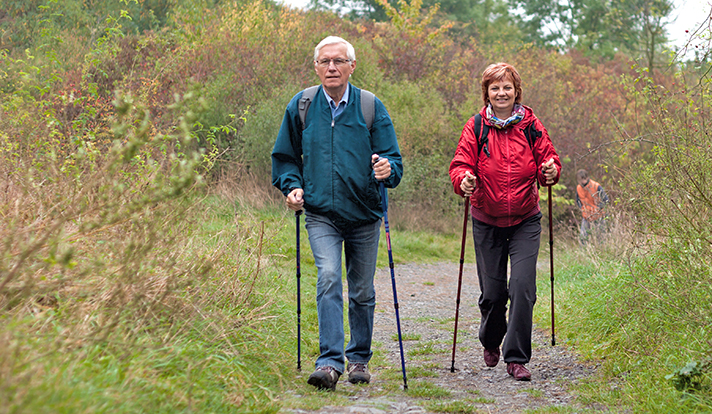Keep moving to prevent major mobility disability

Nordic walking on a trail. Yale University News
HIA Guest Blog, Health in Aging June 9, 2020
Having trouble getting around on your own—such as difficulty walking, climbing steps, or being able to get in and out of a chair—can lead to physical disability and losing your independence.
According to research, being physically inactive is the strongest risk factor for disability as we age.
We know that physical activity has proven health benefits, especially moderate-to-vigorous physical activity such as walking to the store or many types of gardening. But perhaps surprisingly, we don’t know much about the benefits of lighter forms of physical activity or the effects of spreading our physical activity throughout the day. Understanding the benefits of moving more often and engaging in even lighter forms of physical activity is important for older adults’ health. These types of physical activity may be easier for older adults to practice regularly, especially those who are frail.
That’s why a team of researchers created a study to examine the effects of performing light physical activity and moderate-to-vigorous physical activity on older adults. The researchers were interested in studying how participating in these different intensities of activity, and whether a person spreads their physical activity throughout the day, affects the chances for developing a major mobility disability. The participants in the study were older adults who had challenges with physical function and who participated in the Lifestyle Interventions and Independence for Elders (LIFE) study. The researchers published their study in the Journal of the American Geriatrics Society.
The LIFE study examined whether a long-term exercise program could improve a major mobility disability. For the purposes of the study, the researchers considered that participants had a “major mobility disability” if they were unable to walk 400 meters (about one-quarter of a mile, or five city blocks).
The people in the study ranged in age from 70 to 89 years old. Before the study, participants got less than 20 minutes of exercise a week, were able to walk 400 meters in less than 15 minutes, and were determined to be able to safely participate in the study.
The participants were divided into two groups: an exercise group and a group that received health education with no exercise. By the sixth month of the study, the participants in the exercise group performed an additional 40 minutes a week of moderate to vigorous exercise, which they continued after 12 months and 24 months.
The focus of the exercise program was on aerobic activity (exercises that increase your breathing and heart rate), specifically walking. Participants had a goal of completing 150 weekly minutes of moderate to vigorous exercise paired with brief balance, flexibility, and lower-body strengthening exercises. Participants aimed to exercise five to six days per week, including two weekly center-based exercise sessions. For the few weeks of training, participants advanced from exercising at a light intensity to a walking intensity they felt was at least “moderate.”
Of the participants, 818 were randomly assigned to the exercise program and 507 individuals had “accelerometer” information at the beginning of the study. An accelerometer is similar to a pedometer, but it measures both amount and intensity of physical activity.
The researchers found that the intensity of physical activity, as well as the way that physical activity is spread throughout the day, should be matched to each individual’s physical health to minimize their likelihood for developing major mobility disability.
First, they recommend that frail individuals focus on building strength and balance as a key step in preventing mobility disability. Next, as strength and balance develop, older adults should focus on increasing the amount of moderate to vigorous intensity physical activity they do each day through activities like working around the home, walking for transport, or purposeful exercise.
Once individuals develop strength and balance, and engage in at least a small amount of moderate to vigorous activity, they can further reduce their risk for mobility disability by increasing the amount of light activity they do each day, and by spreading this activity across the full day, for instance through hobbies like cooking, woodworking, or light gardening.
The researchers concluded by echoing the current United States Physical Activity Guidelines, suggesting that a “move more, more often” recommendation is a good starting place for older adults who want to maintain physical functioning and an independent lifestyle.
Source Health in Aging
| References |
Relationships Between Profiles of Physical Activity and Major Mobility Disability in the LIFE Study, Fanning J, Rejeski WJ, Chen SH, Guralnik J, Pahor M, Miller ME. . J Am Geriatr Soc. 10.1111/jgs.16386. Advance online publication. https://doi.org/10.1111/jgs.16386. Full text
| Further reading |
Impact and Lessons From the Lifestyle Interventions and Independence for Elders (LIFE) Clinical Trials of Physical Activity to Prevent Mobility Disability, Pahor M, Guralnik JM, Anton SD, Ambrosius WT, Blair SN, Church TS, Espeland MA, Fielding RA, Gill TM, Glynn NW, Groessl EJ, King AC, Kritchevsky SB, Manini TM, McDermott MM, Miller ME, Newman AB, Williamson JD. J Am Geriatr Soc. 2020 Apr;68(4):872-881. doi: 10.1111/jgs.16365. Epub 2020 Feb 27. Full text
Also see
Regular Physical Activity Can Maintain or Improve Frailty Health in Aging
